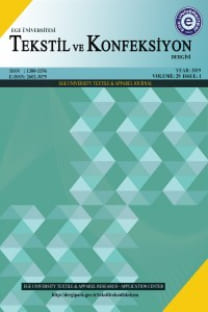AN ECOLOGICAL APPROACH FOR THE SURFACE MODIFICATION OF ARAMID FIBERS
ARAMİD LİFLERİNİN YÜZEY MODİFİKASYONU İÇİN EKOLOJİK BİR YAKLAŞIM
___
- 1. Leal A., Deitzel J.M., McKnight S.H., Gillespie J. W., Interfacial behavior of high performance organic fibers, Polymer (50), 2009, pp. 1228–1235.
- 2. Xi M., Li Y., Shang S., Li D., Yin Y., Dai X., Surface modification of aramid fiber by air DBD plasma at atmospheric pressure with continuous on-line processing, Surface and Coatings Technology, 202 (24), 2008, pp. 6029–6033.
- 3. Jia, C., Chen, P., Wang, Q., Li, B., Chen, M., Surface wettability of atmospheric dielectric barrier discharge processed Armos fibers, 258 (1), 2011, pp.388-393
- 4. Wu J., Cheng X. H., The Effect of Surface Treatment of F-12 Aramid Fibers with Rare Earths on The Interlaminar Shear Strength of Aramid/Epoxy Composites, Mechanics of Composite Materials, 41( 2), 2005, pp. 181-186.
- 5. Gu, R., Yu, J., Hu, C., Zhu, J. et al., Surface treatment of para-aramid fiber by argon dielectric barrier discharge plasma at atmospheric pressure, Applied Surface Science, 258 (24), 2012, pp. 10168-10174
- 6. Ozdogan E., Demir A., Karahan A., et al., Effect of Atmospheric Plasma on Printability of Wool Fabrics, Tekstil ve Konfeksiyon, 2, 2009, pp.123-127.
- 7. Kocum C, Ayhan H., Design and construction of uniform glow discharge plasma system operating under atmospheric condition, Rev Sci Instrum 78(6), 2007, Article number 063501
- 8. Perincek S., Duran K., Körlü A.E., Combination of Ozonation and Hydrogen Peroxide Bleaching for Linen Fabrics: Optimization of the Process Using Experimental Design Technique Ozone: Science & Engineering, 35( 4), 2013, pp. 316-327
- 9. Karahan H.A., Ozdogan E., Improvements of surface functionality of cotton fibers by atmospheric plasma treatment , Fibers and Polymers, 9( 1),2008, pp.21-26.
- 10. Lima M, Hes L, Vasconcelos R, Martins J, Frictor Q. Accessing fabric friction with a novel fabric surface tester, Autex Research Journal 5(4), 2005, pp.194– 201.
- 11. Liu L., Jiang q., Zhu t.,et al.,Influence of Moisture Regain of Aramid Fibers on Effects of Atmospheric Pressure Plasma Treatment on Improving Adhesion with Epoxy. Journal of Applied Polymer Science, 102, 2006, pp. 242–247.
- 12. Poncin-Epaillard F., Chevet B., Jean-Claude B., Study of an Aramid Surface Reactivity: Modification with a Cold Plasma or an Electron Beam Followed by a Postgrafting Reaction, Journal of Applied Polymer Science, 52, 1994, pp.1047-1061.
- 13. Demir A, Seki Y, Bozaci E, Sarikanat M, Erden S, Sever K, et al. Effect of the atmospheric plasma treatment parameters on jute fabric: the effect on mechanical properties of jute fabric/polyester composites. J Appl Polym Sci, 121(2), 2011,pp. 634–638.
- 14. Coffey, A. B., O’Bradaigh, C. M.; Young, R. J. J , Interfacial stress transfer in an aramid reinforced thermoplastic elastomer, Journal of Mater Science, 42(19),2007, pp. 8053-8061.
- 15. Park, S. J.; Seo, M. K.; Lee, J. R., Effect of Fiber-Polymer Interactions on Fracture Toughness Behavior of Carbon Fiber-Reinforced Epoxy Matrix, J Colloid Interface Science, 268(1), 2003, pp.127-130.
- 16. Widodo M., Plasma Surface Modification of Polyaramid Fibers for Protective Clothing, Ph.D. Dissertation, NCSU, 2011
- 17. Yanyan Chu, Xiaogang Chen, David W Sheel and John L Hodgkinson, Surface modification of aramid fibers by atmospheric pressure plasma-enhanced vapor deposition, DOI: 10.1177/0040517513515311
- ISSN: 1300-3356
- Yayın Aralığı: 4
- Yayıncı: Ege Üniversitesi Tekstil ve Konfeksiyon Araştırma & Uygulama Merkezi
MURATA VORTEKS EĞİRME MAKİNESİ PARAMETRELERİNİN SEÇİMİ İÇİN MOORA TABANLI TAGUCHI OPTIMIZASYONU
Esra AKGÜL, Emel KIZILKAYA AYDOĞAN, Diyar AKAY, Hüseyin Gazi TÜRKSOY
Habip DAYIOĞLU, Nigar MERDAN, Seyda EYÜPOĞLU, Mehmet KILINÇ, Dilek KUT
Nigar MERDAN, Dilek KUT, Habip DAYIOĞLU, Mehmet KILINÇ, Seyda EYÜPOĞLU
ARAMİD LİFLERİNİN YÜZEY MODİFİKASYONU İÇİN EKOLOJİK BİR YAKLAŞIM
Aslı DEMİR, Ebru BOZACI, Tülay GÜLÜMSER, Mehmet SARIKANAT
EĞİRME SİSTEMİ VE KARIŞIM ORANININ İPEK/PAMUK KARIŞIM İPLİKLERİNİN KALİTESİNE ETKİSİ
Memik Bünyamin ÜZÜMCÜ, Hüseyin KADOĞLU
FARKLI NAYLON İPLİKLERİNDEN MAMUL ÖRME KUMAŞLARIN ISLANMA VE KURUMA DAVRANIŞLARI
Sena CIMILLI DURU, Cevza CANDAN
MOORA-BASED TAGUCHI OPTIMIZATION FOR SELECTION OF MURATA VORTEX SPINNER MACHINE PARAMETERS
Esra AKGÜL, Hüseyin Gazi TÜRKSOY, Emel KIZILKAYA AYDOĞAN, Diyar AKAY
THE EFFECTS OF SPINNING SYSTEM AND BLENDING RATIO ON QUALITY OF SILK/COTTON BLENDED YARNS
Memik Bünyamin ÜZÜMCÜ, Hüseyin KADOĞLU
DOĞAL RENKLİ PAMUKLU VE BEYAZ PAMUKLU KUMAŞIN BOYAHANEDEKİ PROSESLER AÇISINDAN KARŞILAŞTIRMASI
